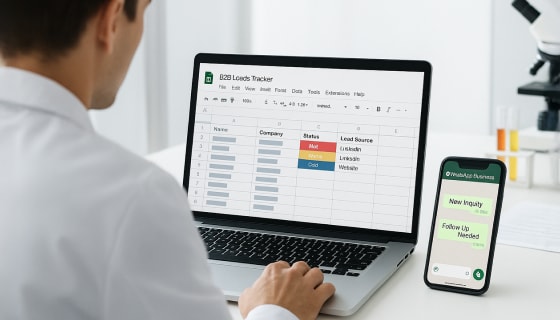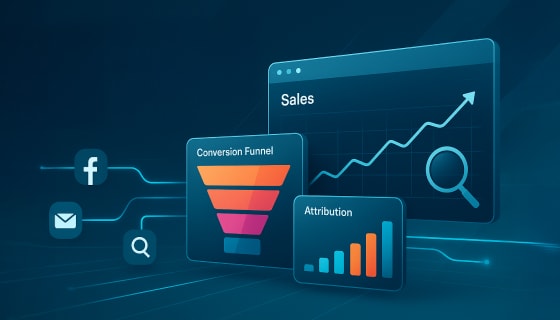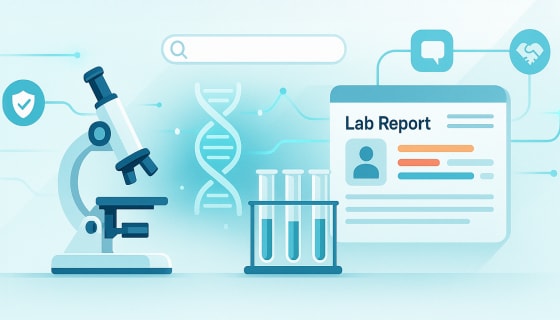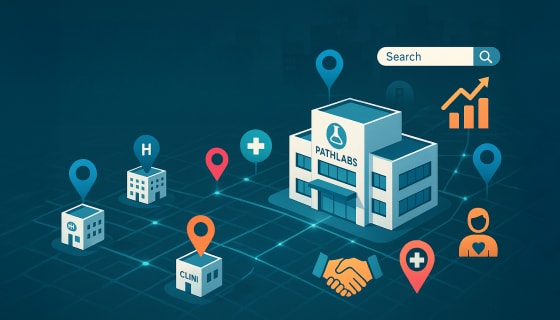Everyone wants their lab to be “in the running” when corporations and hospitals look for a partner. But being great at what you do isn’t the only thing that gets you noticed anymore. These days, B2B healthcare decision-makers will look up your lab online before they ever pick up the phone or respond to an email. According to the article published by the National Library of Medicine, hospital administrators take almost a year to finalize new partnerships and do 70% of their research before ever reaching out. So, what used to work—personal referrals, word-of-mouth, or an impressive price—just isn’t enough anymore. The criteria for making the shortlist now include everything from website credibility to clarity of service, responsiveness, and evidence of reliability.
In this article, we’ll pull back the curtain on how the decision-making journey has evolved for PathLabs and Diagnostic Centers. Together, we’ll explore which stakeholders really matter, what their process looks like behind the scenes, and the clear signals that set you apart as a trusted partner.
Let’s go!
Who Are the Key B2B Decision-Makers in Healthcare?
When it comes to landing a B2B partnership with a hospital, corporate, or major clinic, you’re not just competing for a simple order—these agreements are high-stakes. They’re worth lakhs, bring in steady monthly revenue, and a win like this can single-handedly elevate your lab’s reputation and growth trajectory. But dozens of labs might be pitching for the same spot, all hoping for the attention of a handful of influential decision-makers. That’s why winning just one of these partnerships can mean the difference between steady growth and being left in the waiting room.
But who do you need to impress to win deals this valuable? Here’s a closer look at the key decision-makers and what they’re truly searching for when choosing a lab partner:
Corporate HRs and Employee Wellness Heads
These professionals are on a mission to make employee health programs seamless and impactful. They value labs that deliver not only accurate screening but also provide hassle-free digital onboarding, transparent processes, and easy scheduling for large numbers of employees. Clear and timely communication is essential—they need a lab that consistently updates them about bulk testing drives, accommodates shift timings, and helps them demonstrate the value of wellness initiatives to company leadership. Bonus points if you make reporting and result analysis straightforward for both HR and individual employees.
Hospital Procurement Officers and Admins
Hospital procurement teams hold the keys to sizable, recurring business. They scrutinize internal workflows. Their top priority is finding lab partners with verified compliance credentials, industry accreditations, and a proven track record of managing complex, high-volume requests without sacrificing quality. Professionalism and speed in resolving issues (not just quoting low prices) matter to them, as does your ability to answer regulatory or safety audits with confidence. They seek long-term partners capable of handling pressure, scaling up as needed, and communicating proactively in the event of disruptions.
Clinic Owners and Referring Doctors
For this group, trust is everything. Clinic owners and doctors need to know that their patients’ samples are safe, results are always accurate, and reports arrive on time, sometimes even urgently. Delays or confusion reflect directly on their reputation, so they look for labs that offer fast, consistent turnaround and are reachable for quick clarification. Personal relationships can help, but increasingly, they’ll check your online ratings, read reviews left by peers, and rely on word-of-mouth from colleagues. It’s also important to provide helpful, transparent reporting that clinicians can easily interpret and share with patients.
In every case, these stakeholders seek a partner they can trust to make their work easier and more credible. Understanding what matters most to each decision-maker is key, and that’s what we’ll explore next.
How B2B Labs Find You: A 5-Stage Journey for Partners
Even when you know who the decision-makers are, winning over a hospital, clinic, or corporate client isn’t a single leap. Top labs understand that being selected as a trusted partner involves supporting, impressing, and reassuring stakeholders throughout every stage.
Let’s break down the five key stages every B2B lab partnership decision follows, with practical examples and a closer look at the channels and touchpoints that matter most.

Awareness
The journey begins before you ever get a call or an email. At this stage, stakeholders—including HR heads, procurement officers, or referring doctors—become aware of your lab through multiple channels. This can happen when someone searches “best B2B labs near me” on Google, stumbles on a well-placed ad hears your name in an industry WhatsApp group, or checks LinkedIn for recommendations.
Here are the key ways decision-makers typically discover and become familiar with your lab:
- Organic Search: Ensuring your lab appears in relevant local and industry searches with SEO-optimized content.
- LinkedIn: Active profiles for leadership, regular sharing of industry insights, and engagement with hospital and HR groups.
- Recommendations: Word-of-mouth in WhatsApp groups or professional associations, where a colleague’s single message can spark widespread interest.
- Ads: Targeted digital ads on Google, LinkedIn, or industry sites can reach decision-makers actively looking for service partners.
Example:
A hospital admin sees your lab’s recent blood camp featured in a LinkedIn post and saves your company’s profile for future reference.
Research
Now, the decision-makers “investigate”—often quietly and independently. They’ll browse your website, read Google and GMB reviews (especially those written by other professionals), look at your credentials, and scan landing pages dedicated to B2B partnerships.
At this stage, decision-makers carefully explore specific online and offline resources to verify your credibility and relevance:
- Company Website: Clearly outlines services for corporates, clinics, and hospitals, featuring certifications and process transparency.
- Google Reviews & GMB: High volume of recent, relevant reviews from other healthcare professionals.
- Landing Pages: Well-designed, easy-to-navigate pages that answer the specific needs of B2B partners (pricing, process, turnaround time, compliance).
- Credentials & Accreditations: Easily accessible NABL, CAP, or ISO certifications.
Example:
An HR head searching for screening partners compares your website and reviews with competitors, shortlisting only those that appear credible and have B2B experience.
Evaluation
If your lab impresses during research, you move to the shortlist. At this point, direct engagement begins—decision-makers send inquiries, evaluate your response times, judge communication quality, and even “test” your capacity for flexibility.
When decision-makers reach out, they closely observe your responsiveness, communication style, and flexibility across various contact points, including:
- Inquiry Forms & Contact Channels: How quickly and professionally do you respond?
- Email & WhatsApp Communication: Personalized, clear answers versus downplaying questions.
- Sample Proposal/Quotation: Clarity, customization, and transparency in your initial offer.
- Flexibility: Willingness to accommodate special requirements or timelines.
Example:
A clinic owner emails two labs: one replies within two hours, answers all questions, and shares sample reports, while another responds with a generic brochure two days later. The quicker, thoughtful lab moves ahead.
Internal Approval
Even when the frontline decision-maker is convinced, final approval rests with their wider team—finance, legal, and top management. Your ability to supply transparent pricing, draft MoUs, and work out logistics becomes crucial.
To help the decision-makers get their teams on board, you need to provide transparent and accessible pricing, contracts, and operational details such as:
- Transparent Pricing Sheets: No hidden clauses or complicated fee structures.
- Sample MoU/Contracts: Ready-to-customize, with a focus on compliance and risk mitigation.
- Operational Discussions: Willingness to discuss logistics, SLAs, and escalation processes.
Example:
A hospital’s procurement officer easily shares your well-structured MoU and competitive pricing presentation with finance and legal, making internal sign-off smooth and fast.
Decision
Here, it’s a final gut check about whether your lab feels like the safest, smoothest, most reliable choice. Decision-makers look for a smooth and trustworthy onboarding experience, supported by proactive communication and dedicated support channels such as:
- Onboarding Flow: Guided, easy process for contract signing, communication setup, and first sample collection.
- Welcome Communication: Personal calls, custom onboarding kits, or digital welcome guides reassure nervous clients.
- Ongoing Support: Clear escalation contacts, dedicated relationship managers, and proactive status updates.
Example:
A corporate HR finalizes the tie-up because your onboarding process is transparent, supportive, and prioritizes their needs over simply “closing the deal.”
What Signals Build (or Break) Trust in This Process
In B2B healthcare partnerships, trust is earned through every interaction and every signal your lab sends out. Decision-makers, whether they’re corporate wellness heads or hospital admins, are constantly scanning for clear signs that you’re not only capable but also reliable, professional, and easy to work with. Even one weak signal can raise doubts and push them toward competitors who present a more confident, trustworthy image.
Here are the key trust-builders that can make or break your chances at every stage:
- Website Quality and Clarity: Your website is often the first “real” impression. It needs to be clean, easy to browse, and clearly communicate your B2B services—pricing, process, certifications, and how you handle large-scale partnerships.
- Case Studies or Client Logos: Displaying relevant case studies or recognizable client logos gives a powerful social proof boost. It shows that others in the healthcare or corporate space have trusted you and benefited from your services, reassuring prospects that they’re making the right choice.
- Service Availability and Turnaround Time: Fast sample processing and reliable turnaround times aren’t just nice-to-haves—they’re expectations. If your service availability or timing is inconsistent or unclear, decision-makers will hesitate to count on you for the critical needs of their employees or patients.
- GMB Reviews from Professionals: Google My Business (GMB) reviews, especially those written by other healthcare professionals or corporate clients, carry significant weight. Authentic reviews that highlight your professionalism and quality reinforce your credibility, while negative or sparse reviews can raise red flags.
- Response Time to Inquiries: When a decision-maker reaches out, how quickly and attentively you respond can be a deal-maker or breaker. Delayed or canned responses feel impersonal and unprofessional—they hint at future communication difficulties and a lack of respect for the prospective partnership.
- Human Follow-Ups vs. Generic Templates: Personalized follow-ups demonstrate that you value the relationship and understand the unique needs of the partner. Over-reliance on generic email templates or automatic replies can make you seem disconnected or uninterested, costing you critical trust points.
When you pay close, timely attention to these signals, you don’t just become another vendor—you become the go-to partner your clients rely on, now and in the long run. To make this even easier for you, we’ve put together a handy checklist to help you quickly see where you stand and what you can improve to be truly B2B-ready.
A Quick Checklist to See if You’re B2B-Ready
Use this practical checklist to audit your lab’s readiness for B2B partnerships with hospitals, corporations, and clinics. Try to tick off each point honestly—every box you check gets you closer to becoming the partner of choice!
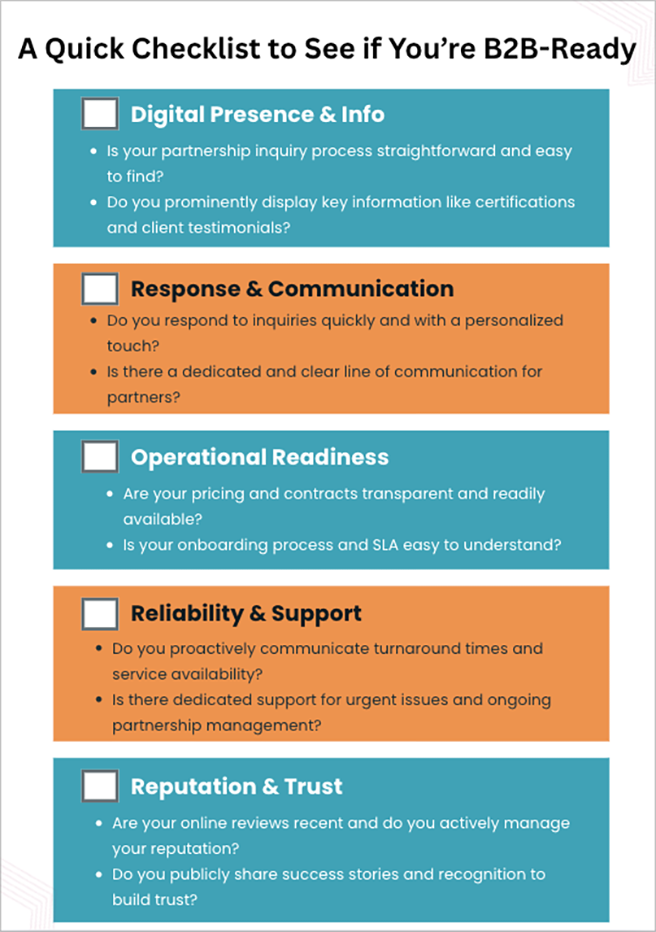
Conclusion
In the B2B healthcare space, success isn’t about pushing or selling aggressively. Instead, it’s about being transparent in your communication, credible in every promise you make, and approachable at every touchpoint. When you focus on showing up authentically—ready with clear information, trustworthy credentials, and genuine responsiveness—you naturally earn the confidence of decision-makers.
Remember, B2B growth comes from showing up prepared. It’s the preparedness that sets you apart and turns prospects into long-term partners. If you want to dive deeper and get practical tools, strategies, and insider insights, download our detailed eBook crafted specifically for PathLab and Diagnostic Centre owners aiming to master the modern B2B decision-making landscape.
Join the table where healthcare decisions are made—be prepared, be genuine, and watch your partnerships grow.




